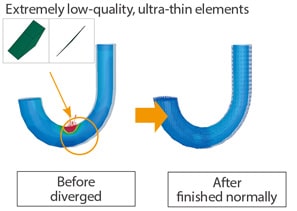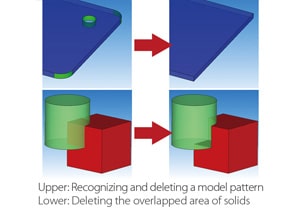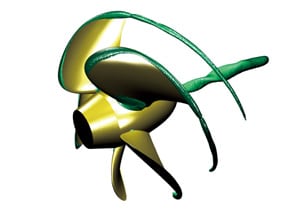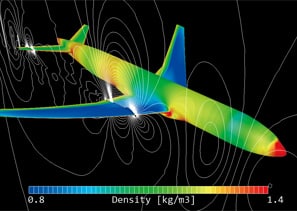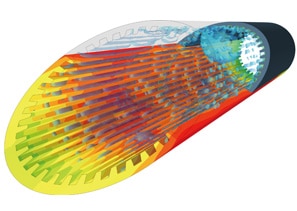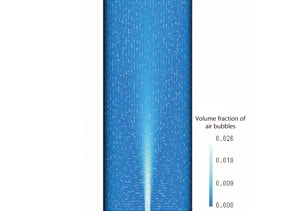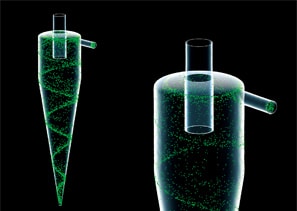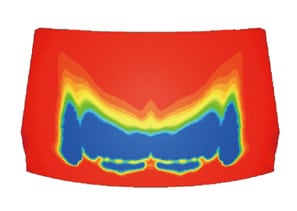scFLOW is a cutting-edge Computational Fluid Dynamics (CFD) software developed by Software Cradle, designed to deliver advanced simulation capabilities with a user-friendly interface. scFLOW offers enhanced stability and speed, making it ideal for engineers and researchers aiming to simulate complex fluid dynamics scenarios. scFLOW’s innovative features, such as a new solver, polyhedral mesher, and enhanced CAD data handling, ensure precise and efficient analysis, making it a preferred choice for professionals in the field of thermo-fluid analysis.
Product Brochure – Cradle CFD
Download a PDF brochure on thermo-fluid analysis software developed and provided by Software Cradle.
File Type: PDF – [1.34 MB]
Get in touch
Your inquiry will be replied by local representative, which may take up to 24 business hours.
We may not be able to provide answers to some inquiries.
Features
The new generation CFD software, scFLOW, has been developed as a state-of-the-art tool, incorporating a wide range of new technologies and user-friendly features. The software now includes a new Solver that offers enhanced stability and up to three times faster calculation speeds. Additionally, the new Preprocessor makes it easier for entry-level users to build complex models and high-quality meshes. The software continues to evolve and improve.
Program Structure
Simplification of Preprocessor operations
The process from CAD data to analysis mesh data has been significantly simplified compared to previous versions. The preservation of assembly information and the ability to set conditions directly on parts provide a seamless transition from CAD operations, reducing the operational burden on users.
Polyhedral mesher
Using polyhedral mesh elements in scFLOW enhances the stability and calculation accuracy of the cell-centered solver. In scFLOWpre, the mesh can be generated according to the target number of mesh elements and automatically refined near wall areas. The automatic mesher function also allows users to specify the mesh refinement level for each part and region.
Viewer mode
In scFLOW, Preprocessor data can be displayed in viewer mode without requiring a Pre-/Post-processor license when the license is occupied by the mesher or Postprocessor and is unavailable.
Stabilization of calculation
This function can analyze passive translation alongside the rotation of an object influenced by fluid forces. The moving object is assumed to be a rigid body, allowing for calculations of movement with up to six degrees of freedom (3D translation + 3D rotation) within scSTREAM. For example, the function can simulate floating leaves being carried by water flow.
Modifying CAD data
When CAD data intended for simulation has issues, it can be modified using the Preprocessor. Boundary conditions can be set based on the part names and color information defined in the CAD data. If any regions are missing in the model, shapes such as cuboids and cylinders can be added to complete the geometry.
Mesh-adaptation analysis
With scFLOW’s mesh-adaptation analysis function, the mesh is automatically refined in areas where flow or pressure changes significantly during a steady-state analysis. After the Solver completes the calculation, the Preprocessor automatically launches and executes gridding and meshing based on the calculation results. By specifying the target number of elements, a coarse mesh is generated first, and then the mesh is automatically refined to an appropriate level for the calculation. This function is particularly useful for analyzing flows in tubes with complex shapes.
Discontinuous mesh
In scFLOW, calculations involving moving objects, such as the rotation of a fan or the translation of cars passing each other, can be performed. The calculation accuracy of element connections has been enhanced by revising the algorithm. In the HPC edition of the Solver, memory consumption efficiency has been improved, which is expected to have significant benefits in multi-core calculations of large-scale data.
Overset mesh
scFLOW now supports the free movement of regions, which cannot be analyzed using existing functions, such as stretching or rotating elements, by overlapping mesh elements for stationary and moving regions. This function supports the overlap of multiple moving regions, contact between objects, and 6-degree-of-freedom motion of rigid bodies. It is particularly useful for analyzing the opening and closing of a valve in an engine port or the engagement of gears in a gear pump.
Free surface (steady-state / transient)
In scFLOW, the shape of an interface between a gas and a liquid can be simulated using the VOF method, with a new approach called FIRM that provides fast and accurate calculations. This method can be combined with functions such as moving boundary, overset mesh, and particle tracking. Additionally, phenomena where the phase interface stabilizes can be analyzed in a steady-state calculation, allowing results to be obtained more quickly than before.
6-degree-of-freedom motion (6DOF)
To thoroughly calculate heat transfer conditions based on the wiring patterns of a printed circuit board (PCB), the module processes Gerber data output from electrical CAD software and imports this data as a model for thermo-fluid analysis. By utilizing Gerber data and considering heat transfer from uneven wiring patterns, scSTREAM can deliver more realistic and accurate calculation results.
Cavitation
This function enables the simulation of cavitation, a vaporization phenomenon that occurs when the pressure of a liquid drops below that of the surrounding area, such as with a high-speed propeller rotating underwater. The occurrence of cavitation can be predicted by applying a cavitation model based on pressure values. The software also supports the analysis of problems caused by cavitation, such as erosion.
Fluid-structure interaction
This option enables two-way FSI (fluid-structure interaction) with structural analysis software. With this option, both rigid and elastic bodies can be analyzed. It allows for the simulation of object deformation caused by fluid forces and the subsequent changes in fluid behavior due to the deformation.
Compressible fluid
The software can analyze phenomena such as supersonic flow and significant volume expansion or contraction. For compressible fluids, both pressure-based and density-based Solvers are available. The density-based Solver ensures stable calculations even at high Mach numbers. Users can select the appropriate Solver depending on the analysis target and the specific phenomenon being studied.
Evaporation/Condensation
The free surface analysis function (VOF method) in this software can simulate phase changes between gas and liquid, such as evaporation and condensation. By considering phase changes, the software can calculate not only simple heat conduction but also heat transfer from latent heat. For example, this method can be applied to internal flow simulations for heat transfer devices like heat pipes, where a refrigerant liquid changes to vapor by absorbing heat from an external region.
Dispersed multi-phase flow
scFLOW can simulate flows containing numerous bubbles, droplets, or particles (dispersed phase), which are challenging to analyze using the free surface method. This multi-fluid model predicts the volume fraction distribution and velocity distribution of each phase by solving the governing equations under the assumption that the dispersed phase behaves as a fluid (continuous phase). This function is particularly useful for analyzing bubble jet effects and aeration tanks.
Particle tracking
The particle tracking function in scFLOW enables the analysis of particle behavior in a flow. For small particles that follow the fluid’s movement, such as steam and dust, the marker particle function can be used. This function evaluates the particles’ movement over time, assuming that their motion corresponds to the fluid velocity.
Humidity dew condensation
The amount of dew condensation on a surface can be calculated based on the surface temperature and water vapor in the air. In a steady-state analysis, you can output the amount of dew condensation per unit time, while in a transient analysis, the accumulated dew condensation can be calculated. Evaporation from a surface where dew condensation occurs can also be calculated simultaneously, making this function particularly useful for analyzing windshield defrosters.
Liquid film model
The liquid film model is an extension of the particle tracking function. With this model, users can simulate the phenomenon where liquid particles form a liquid film (such as water on a wall) when they reach a surface. A liquid film on a wall flows under the influence of gravity and gas-phase flow, depending on the wall’s angle, and collects at certain positions. The analysis results are output as the thickness of the liquid film.
Thermoregulation-model (JOS)
The combined use of the thermoregulation model (JOS) and fluid analysis allows for the simulation of surface temperature on the human body in a given thermal environment. This approach can also be used to analyze temperature and humidity changes in the surrounding environment of a human body. Users can account for factors such as age, clothing, and physiological phenomena like heat transfer through blood flow, in addition to environmental factors like temperature and air velocity.
LES
Heat transfer by infrared radiation can be analyzed by setting the emissivity and temperature difference between objects. Users can choose between the VF (View Factor) method or the FLUX method as the calculation approach. Additionally, wavelength dependence, transmission, absorption, refraction, diffusion, and reflection of radiation can be considered. The FLUX method also allows for the consideration of directionality.
Radiation
Heat transfer by infrared radiation can be analyzed by setting the emissivity and temperature difference between objects. Users can choose between the VF (View Factor) method or the FLUX method as the calculation approach. Additionally, wavelength dependence, transmission, absorption, refraction, diffusion, and reflection of radiation can be considered. The FLUX method also allows for the consideration of directionality.
Fan model (rotating blades)
With this model, the average flow field around rotating blades can be simulated by simply entering characteristic properties, without needing the actual shapes of fans or propellers. Users can utilize the non-dimensional swirl coefficient model, the simplified propeller model, and the simplified rotor model. This approach is particularly useful for analyzing axial-flow windmills and waterwheels.
Coupled analysis with GT-SUITE
The amount of dew condensation on a surface can be calculated based on the surface temperature and water vapor in the air. In a steady-state analysis, you can output the amount of dew condensation per unit time, while in a transient analysis, the accumulated dew condensation can be calculated. Simultaneously, evaporation from the surface where dew condensation occurs can be analyzed, making this particularly useful for windshield defroster simulations.
Operation logging by VB interface
Operations in the Preprocessor can be saved as a log file using the VB interface. This eliminates the need for user scripting, making it possible to quickly and affordably construct an automated system based on the files storing the operation logs.
Script functions
The amount of dew condensation on a surface can be calculated based on the surface temperature and the water vapor present in the air. In a steady-state analysis, the amount of dew condensation per unit time can be output, while in a transient analysis, the accumulated dew condensation can be calculated. Additionally, evaporation from the surface where dew condensation occurs can be analyzed simultaneously, making this particularly useful for windshield defroster simulations.





